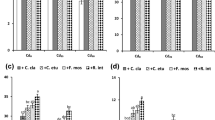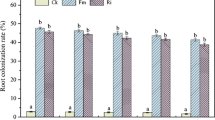Abstract
A pot culture experiment was carried out to investigate the roles of Glomus mosseae in Cu and Pb acquisition by upland rice (Oryza sativa L.) and the interactions between Cu and Pb. The soil was treated with three Cu levels (0, 100 and 200 mg kg−1) and three Pb levels (0, 300, and 600 mg kg−1). All treatments were designed with (+M) or without (−M) G. mosseae inoculation in a randomized block design. The addition of Cu and Pb significantly decreased root mycorrhizal colonization. Compared with −M, +M significantly increased root biomass in almost all treatments, and also significantly increased shoot biomass in the Pb0Cu200, Pb300Cu0, and all Pb600 treatments. AM fungi enhanced plant Cu acquisition, but decreased plant Cu concentrations with all Cu plus Pb treatments, except for shoot in the Cu200Pb600 treatment. Irrespective of Cu and Pb levels, +M plants had higher Pb uptakes than −M plants, but had lower root Pb and higher shoot Pb concentrations than those of −M plants. Another interpretation for the higher shoot Pb concentration in +M plants relied on Cu–Pb interactions. The study provided further evidences for the protective effects of AM fungi on upland rice against Cu and Pb contamination, and uncovered the phenomenon that Cu addition could promote Pb uptake and Pb partitioning to shoot. The possible mechanisms by which AM fungi can alleviate the toxicity induced by Cu and Pb are also discussed.
Similar content being viewed by others
References
Andrade SAL, Abreu CA, de Abreu MF, Silveira APD (2004) Influence of lead additions on arbuscular mycorrhiza and Rhizobium symbioses under soybean plants. Appl Soil Ecol 26:123–131
Andrade SAL, Gratǎo PL, Azevedo RA, Silveira APD, Schiavinato MA, Mazzafera P (2010) Biochemical and physiological changes in jack bean under mycorrhizal symbiosis growing in soil with increasing Cu concentrations. Environ Exp Bot 68:198–207
Blaudez D, Botton B, Chalot M (2000) Cadmium uptake and subcellular compartmentation in the ectomycorrhizal fungus Paxillus involutus. Microbiology 146:1109–1117
Bolan NS (1991) A critical review on the role of mycorrhizal fungi in the uptake of phosphorus by plants. Plant Soil 134:189–207
Chen BD, Shen H, Li XL et al (2004) Effects of EDTA application and arbuscular mycorrhizal colonization on growth and zinc uptake by maize (Zea mays L.) in soil experimentally contaminated with zinc. Plant Soil 261:219–229
Chen BD, Duan J, Xiao XY, Smith SE, Zhu YG (2007) Effects of the arbuscular mycorrhizal fungus Glomus mosseae on growth and metal uptake by four plants pecies in copper mine tailings. Environ Pollut 147:374–380
Christie P, Li XL, Chen BD (2004) Arbuscular mycorrhiza can depress translocation of zinc to shoots of hostplants in soils moderately polluted with zinc. Plant Soil 261:209–217
Frey B, Zierold K, Brunner I (2000) Extracellular complexation of Cd in the Hartig net and cytosolic Zn sequestration in the fungal mantle of Piceaabies-Hebeloma crustuliniforme ectomycorrhizas. Plant Cell Environ 23:1257–1265
Giovannetti M, Mosse B (1980) An evaluation of techniques for measuring vesicular–arbuscular mycorrhizal infection in roots. New Phytol 84:489–500
Joner EJ, Leyval C (1997) Uptake of 109Cd by roots and hyphae of a Glomus mosseae/Trifolium subterraneum mycorrhiza from soil amended with high and low concentrations of cadmium. New Phytol 135:353–360
Joner EJ, Briones R, Leyval C (2000) Metal-binding capacity of arbuscular mycorrhizal mycelium. Plant Soil 226:227–234
Khan AG, Kueck TM, Chaudrhry CS et al (2000) Role of plants, mycorrhizae and phytochelators in heavy metal contaminated land remediation. Chemosphere 41:197–207
Kothari SK, Marschner H, Römheld V (1990) Direct and indirect effects of VA mycorrhizal fungi and rhizosphere microorganisms on acquisition of mineral nutrients by maize (Zea mays L.) in a calcareous soil. New Phytol 110:637–745
Kothari SK, Marschner H, Romheld V (1991) Effect of a vesicular-arbuscular mycorrhizal fungus and micro-organisms on manganese reduction in the rhizosphere and manganese concentrations in maize (Zea mays L.). New Phytol 117:649–655
Kucey RMN, Janzen HH (1987) Effects of reduced nutrient availability on growth and phosphorus and micronutrient uptake of wheat and field beans under green house conditions. Plant Soil 104:71–78
Leyval C, Joner EJ (2001) Bioavailability of heavy metals in the mycorrhizosphere. In: Gobran RG, Wenzel WW, Lombi E (eds) Trace Metals in the Rhizosphere. CRC Press, Florida, pp 165–185
Leyval C, Turnau K, Haselwandter K (1997) Effect of heavy metal pollution on mycorrhizal colonisation and function, physiological, ecological and applied aspects. Mycorrhiza 7:139–153
Liao JP, Lin XG, Cao ZH et al (2003) Interactions between arbuscular mycorrhizae and heavy metals under sand culture experiment. Chemosphere 50:847–853
Lin A-J, Zhang X-H, Wong MH, Ye ZH, Lou LQ, Zhu YG (2007) Increase of multi-metal tolerance of three leguminous plants by arbuscular mycorrhizal fungi colonization. Environ Geochem Health 29:473–481
Lins CEL, Cavalcante UMT, Sampaio EVSB, Messias AS, Maia LC (2006) Growth of mycorrhized seedlings of Leucaena leucocephala (Lam.) de Wit. In a copper contaminated soil. Appl Soil Ecol 31:181–185
Liu A, Hamel C, Hamilton RI, Ma BL, Smith DL (2000) Acquisition of Cu, Zn, Mn and Fe by mycorrhizal maize (Zea mays L.) grown in soil at different Pand micro nutrient levels. Mycorrhiza 9:331–336
Ma Y, Dickinson NM, Wong MH (2006) Beneficial effects of earth worms and arbuscular mycorrhizal fungi on establishment of leguminous trees on Pb/Zn mine tailings. Soil Biol Biochem 38:1403–1412
Marschner P, Jentschke G, Goldbold DL (1998) Cation exchange capacity and lead sorption in ectomycorrhizal fungi. Plant Soil 205:93–98
Ouziad F, Hildebrandt U, Schmelzer E, Bothe H (2005) Differential gene expressions in arbuscular mycorrhizal-colonized tomato grown under heavy metal stress. J Plant Physiol 162:634–649
Philips JM, Hayman DS (1970) Improved procedures for clearing roots and staining parasitic and vesicular arbuscular mycorrhizal fungi for rapid assessment of infection. Trans Br Mycorrhizal Soc 55:158–160
Smith SE, Read DJ (1997) Mycorrhizal symbiosis. Academic Press, London
Vogel-Mikuš Katarina, Damjana Drobne, Marjana Regvar (2005) Zn, Cd and Pb accumulation and arbuscular mycorrhizal colonisation of pennycress Thlaspi praecox Wulf. (Brassicaceae) from the vicinity of a lead mine and smelter in Slovenia. Environ Pollut 133:233–242
Wang FY, Lin XG, Yin R (2007) Inoculation with arbuscular mycorrhizal fungus Acaulospora mellea decreases Cu phytoextraction by maize from Cu-contaminated soil. Pedobiologia 51:99–109
Weissenhorn I, Leyval C (1995) Root colonization of maize by a Cd-sensitive and Cd-tolerant Glomus mosseae and cadmium uptake in sand culture. Plant Soil 175:233–238
Wu FY, Bi YL, Leung HM, Ye ZH, Lin XG, Wong MH (2010) Accumulation of As, Pb, Zn, Cd and Cu and arbuscular mycorrhizal status in populations of Cynodon dactylon grown on metal-contaminated soils. Appl Soil Ecol 44:213–218
Zhang XH, Zhu Y-G, Chen BD, Lin AJ, Smith SE, Smith FA (2005) Arbuscular mycorrhizal fungi contribute to the resistance of upland rice to combined metal contamination of soil. J Plant Nutr 28(12):2065–2077
Zhang X-H, Lin A-J, Chen BD, Smith SE, Smith FA (2006) Effects of Glomus mosseae on the toxicity of heavy metals to Vicia faba. J Environ Sci 18(4):721–726
Zhang X-H, Lin A-J, Gao Y-L, Reid RJ, Wong M-H, Zhu Y-G (2009) Arbuscular mycorrhizal colonization increases copper binding capacity of root cell walls of Oryza sativa L. and reduces copper uptake. Soil Biol Biochem 41:930–935
Acknowledgments
This study was supported by the National Natural Science Foundation of China (40901149 and 81072989).
Conflict of interest
The authors declare that they have no conflict of interest.
Author information
Authors and Affiliations
Corresponding author
Rights and permissions
About this article
Cite this article
Lin, A., Zhang, X. & Yang, X. Glomus mosseae enhances root growth and Cu and Pb acquisition of upland rice (Oryza sativa L.) in contaminated soils. Ecotoxicology 23, 2053–2061 (2014). https://doi.org/10.1007/s10646-014-1368-6
Accepted:
Published:
Issue Date:
DOI: https://doi.org/10.1007/s10646-014-1368-6




